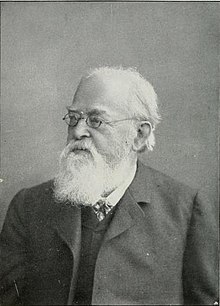|
Karl Heinrich Ritthausen
Karl Heinrich Ritthausen (13 January 1826 – 16 October 1912) was a German biochemist who identified two amino acids and made other contributions to the science of plant proteins. EducationRitthausen was born in Armenruh, near Goldburg, Silesia, Prussia, in today's Poland. Ritthausen's first advanced education in chemistry was in Leipzig and Bonn. He began to do research in Giessen with Justus von Liebig, and was inspired to continue investigation into agricultural chemistry. He returned to Leipzig to study with Otto Linné Erdmann. He was awarded the doctorate degree in 1853. The agricultural experiment stations at Möckern and Ida-Marienhütte were the locations of his first professional appointments. In 1862 he began to publish articles on the proteins of wheat. Protein chemistryThe site of the experiment station became Poppelsdorf in 1867 when Ritthausen became professor of chemistry at University of Bonn. Working with gliadin, he identified α-aminoglutaric acid or glutamic acid in 1866. Then he identified aspartic acid in an almond extract. These findings extended chemical awareness of functional groups in protein, and appeared in the Journal für Praktische Chemie. Ritthausen published Protein bodies in grains, legumes, and linseed. Contributions to the physiology of seeds for cultivation, nutrition, and fodder[1] in 1872, summarizing the science of proteins in relation to plant physiology and animal nutrition. While in Bonn he got married. From 1873 to 1899, Ritthausen was professor of chemistry at University of Königsberg. He retired, moved to Berlin in 1903, and died there on 16 October 1912. AppreciationIn his biography of Ritthausen, Thomas Burr Osborne stated his admiration:
Technical advances by Ritthausen were cited in 1942:
A bibliography of Ritthausen’s works was published in 1913 by the Biochemical Bulletin 2:339–46. It was assembled by Lewis W. Fetzer of Georgetown University and the U.S. Department of Agriculture. References
|
||||||||||||||||||
